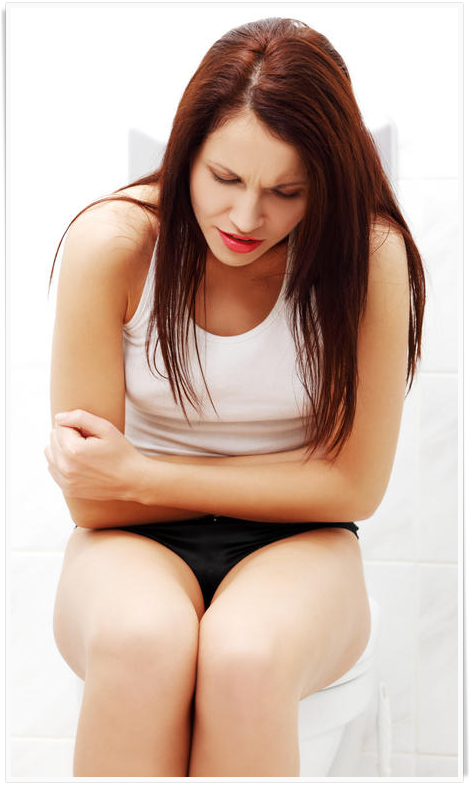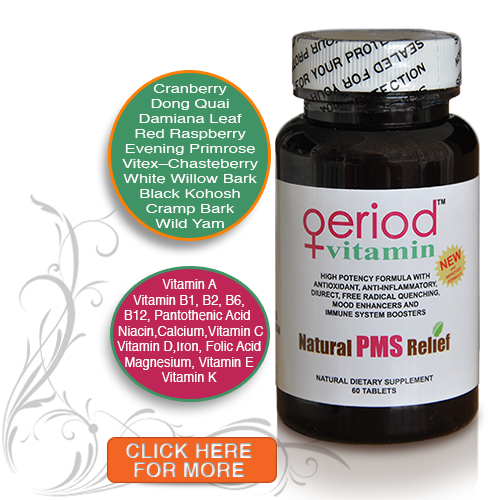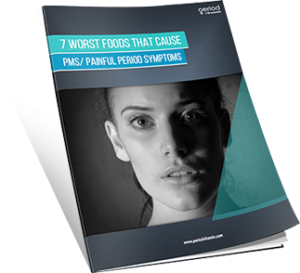 This is a question that many women look forward to hearing the answer to it. Pre-menstrual Syndrome and period pain affect tens of thousands of women throughout the world every month. With symptoms such as abdominal cramps, back pain, mood swings and fluid retention, pms is one of the most difficult ailments women have to deal with and do so on a consistent monthly basis.
This is a question that many women look forward to hearing the answer to it. Pre-menstrual Syndrome and period pain affect tens of thousands of women throughout the world every month. With symptoms such as abdominal cramps, back pain, mood swings and fluid retention, pms is one of the most difficult ailments women have to deal with and do so on a consistent monthly basis.
What is pre-menstrual syndrome and what is the best pms treatment?
In the weeks prior to the beginning of the bleeding stage in a woman’s menstrual cycle her body suffers from a major hormonal imbalance due to first an influx of estrogen, followed by an influx of progesterone. These two hormonal changes in the weeks prior to the start of menses can cause inflammations, an increase in prostaglandins, fluid retention, weight gain, food cravings, headaches, migraines, lower back pain and abdominal cramping along with many changes in the neurological systems leading to extreme pms mood swings and fatigue.
For centuries women have searched for a cure or at the very least an effective treatment for the symptoms of pms. Medical professionals have attempted to treat the individual symptoms with prescription pharmaceuticals. This would include the use of prescription strength analgesics (pain medications narcotic and non-narcotic), anti-inflammatory agents such as NSAIDS (non-steroidal anti-inflammatory drugs) and steroids. A physician might also prescribe anti-depressant or anti-anxiety medications along with medication for migraine headaches. All of this would depend upon the symptoms being treated.
The woman suffering from pre-menstrual syndrome might also choose to take a lesser dose of these medications that can be purchased over the counter without a prescription. Doctors also sometimes prescribe the use of a heating pad or hot water bottle for abdominal cramps. There are also a few over the counter (OTC) medications that are designed specifically to treat multiple pms symptoms at once. This would include drugs such as Midol and Pamprin.
All of these measures treat some but never all of the pms symptoms. Therefore many women have turned to other preventive and treatment measures including herbs, vitamins and minerals.
What then is the role of calcium in pms and what is the benefit of calcium in treating pms?
 Recent studies have shown that calcium has a positive role to play in treating pre-menstrual syndrome especially for treating menstrual cramps. It has been known by women for some time that menstrual cramps can sometimes be treated effectively and reduced by increased intake of calcium and magnesium. Calcium is also being seen as a potentially effective treatment for PMDD (Premenstrual Dysphoric Disorder).
Recent studies have shown that calcium has a positive role to play in treating pre-menstrual syndrome especially for treating menstrual cramps. It has been known by women for some time that menstrual cramps can sometimes be treated effectively and reduced by increased intake of calcium and magnesium. Calcium is also being seen as a potentially effective treatment for PMDD (Premenstrual Dysphoric Disorder).
It seems that magnesium in conjunction with calcium is much more effective for pms and PMDD than is calcium by itself. “In the largest study, women took 1200mg per day and had almost a 50% reduction in their symptoms.”
ezinearticles.com/?Calcium-Supplements-For-PMS-and-PMDD-Treatment
There have been studies that seem to indicate that a deficiency in calcium might even be causative for pms and PMDD. A lack of calcium might be responsible for hypertension and some forms of cancer as well as pms symptoms.
Most adults do not ingest enough calcium through the food we eat and this is particularly true of women. Calcium to prevent osteoporosis has been recommended to women of menopausal years for some time. Adults should get up to 1000 mg every day but most only get 600 mg or so.
There is a study done by J. Tian, P. Bernstein, P. Starkey and S. Thys-Jacobs from St. Luke’s-Roosevelt Hospital Center, College of Physicians and Surgeons, Columbia University in New York that showed a major reduction in the pms symptoms with an increase in calcium. This is particularly true of the symptoms that occur in the third phase of the menstrual cycle – the luteal phase. In this phase the women’s body is flooded with progesterone and this counter balances the increase in estrogen that occurs in the second or follicular phase.
“Seven hundred twenty women were screened for this trial; 497 women were enrolled; 466 were valid for the efficacy analysis. There was no difference in age, weight, height, use of oral contraceptives, or menstrual cycle length between treatment groups. There were no differences between groups in the mean screening symptom complex score of the luteal (P = .659), menstrual (P = .818), or intermenstrual phase (P = .726) of the menstrual cycle.
During the luteal phase of the treatment cycle, a significantly lower mean symptom complex score was observed in the calcium-treated group for both the second (P = .007) and third (P < .001) treatment cycles. By the third treatment cycle calcium effectively resulted in an overall 48% reduction in total symptom scores from baseline compared with a 30% reduction in placebo. All 4 symptom factors were significantly reduced by the third treatment cycle.
CONCLUSIONS: Calcium supplementation is a simple and effective treatment in premenstrual syndrome, resulting in a major reduction in overall luteal phase symptoms.” www.algaecal.com/pms-treatment
Further studies have revealed that calcium alone is effective but not nearly as effective as calcium with magnesium, or with vitamin B6, vitamin D, or zinc.
“While previous studies have shown that calcium could help women significantly reduce PMS symptoms, this research shows that consuming enough calcium and vitamin D could actually lower your risk of developing PMS in the first place.” chealth.canoe.ca/channel_section_details
“Researchers at the University of Massachusetts set out to determine the effect of calcium and vitamin D consumption on pre-menopausal women by comparing women who had developed PMS with those who hadn’t. Participants were between 27 and 44 years old at the start of the study and hadn’t reported any symptoms of PMS. But over the next 10 years, 1,057 women went on to develop PMS, while 1968 did not.”
“the researchers found that women who had the highest vitamin D intake,(an average of 706 IU per day) had a 41% lower chance of developing PMS than the women who had the lowest intake. Women who consumed the equivalent of about 4 servings of skim or low-fat milk (providing approximately 1200 mg of calcium and 400 IU of vitamin D) per day also had a 30% lower chance of developing PMS compared to women who got the least calcium.” chealth.canoe.ca/channel_section_details
This study and others show that calcium with vitamin D as well as calcium with magnesium, with vitamin B complex or with other herbs and minerals is much more effective than calcium by itself. There are many other vitamins, minerals and herbs that are effective in treating and perhaps even preventing many of the symptoms of pre-menstrual syndrome. In this regard there are several products on the market that contain a variety of ingredients that will help to reduce pms symptoms. Among these is Period Vitamin which contains many of the herbal remedies that women have used for centuries to deal with period pain.
Period Vitamin includes these herbal remedies along with minerals like calcium, iron and magnesium and a variety of vitamins.
There are over 20 ingredients in Period Vitamin with at least nine herbs, three minerals and eight vitamins.
This combination of vitamins, herbs and minerals can treat pms symptoms including cramping, fluid retention and bloating during period, acne, mood swings, headaches and migraines, decreased sexual desire, tender swollen breasts, sleep issues and weight gain.
Calcium is very effective in combination with these other herbs, minerals and vitamins. Calcium can reduce the pain from cramps and fluid retention as well as assisting in relieving other types of pain that women suffer through with pms.
“A 10-year study at the University of Massachusetts – Amherst revealed women who included a sufficient amount of calcium in their diets reduced PMS symptoms by 30%. And according to Boston’s Beth Israel Deaconess Medical Center a large double-blind, placebo-controlled study found calcium significantly reduced mood swings, pain, bloating, depression, back pain, and food cravings.”
Calcium needs some of the other ingredients in Period Vitamin in order to be absorbed fully by the body. This is particularly true of vitamin C (ascorbic acid) and magnesium, both of which are needed in the process of absorbing calcium. Vitamin D also plays a role in the absorption of calcium by the body. So you will find magnesium, vitamin C and vitamin D in Period Vitamin. Calcium is important to the central nervous system, the function of blood clotting and also to the muscular system.
Some of the most important ingredients in Period Vitamin along with calcium include:
 Evening Primrose Oil: “In a noteworthy clinical study performed at St. Thomas Hospital in London, 70 women were administered Evening Primrose three times daily. Forty-seven women experienced total relief. Another fifteen experienced partial relief. And not one of these women had previously responded to “conventional” treatments.”
Evening Primrose Oil: “In a noteworthy clinical study performed at St. Thomas Hospital in London, 70 women were administered Evening Primrose three times daily. Forty-seven women experienced total relief. Another fifteen experienced partial relief. And not one of these women had previously responded to “conventional” treatments.”
- Chasteberry: Several pms symptoms are addressed by Chasteberry including acne, bloating, migraines, breast tenderness, mood changes and decreased sexual interest.
- Black Cohosh: Native Americans used this for centuries to reduce pms symptoms.
- White Willow Bark: Native Americans and ancient Chinese also used this herb. It is a natural analgesic or pain killer.
- Iron: Helps with the clotting and oxygenation of the blood and can impact the heaviness and the length of a woman’s menses.
- Vitamin B complex: There are so many pms symptoms that are added by members of the vitamin B complex including stress and depression.
So you can see that a product like Period Vitamin is a much better solution to the pain and discomfort of pre-menstrual syndrome than calcium on its own. Regardless it is clear that calcium remains a very, very important mineral in treating and perhaps even in preventing some of the major and most troublesome aspects and symptoms of pms.


